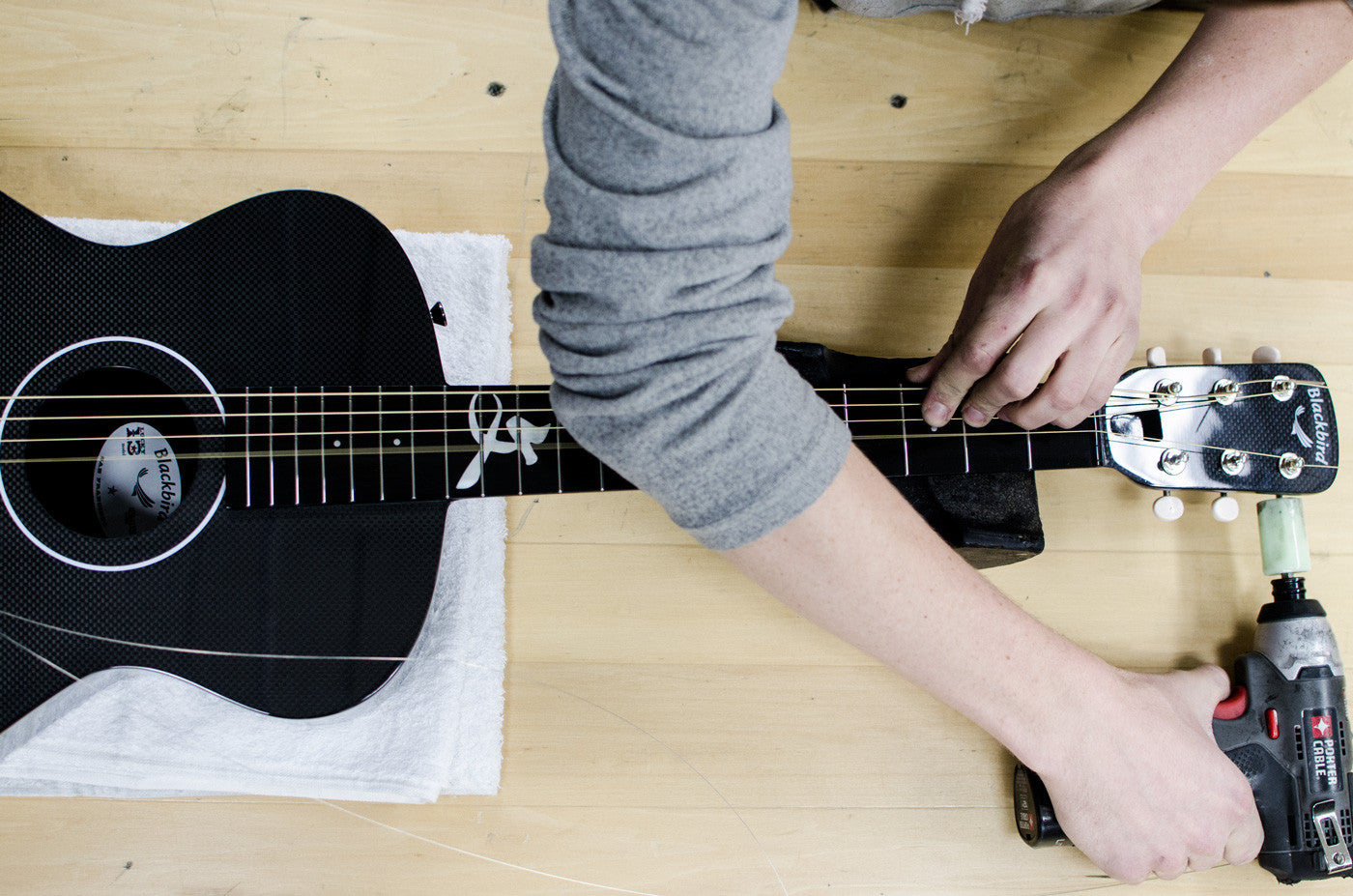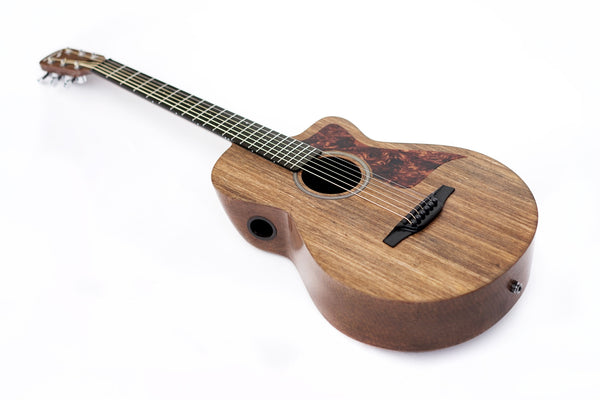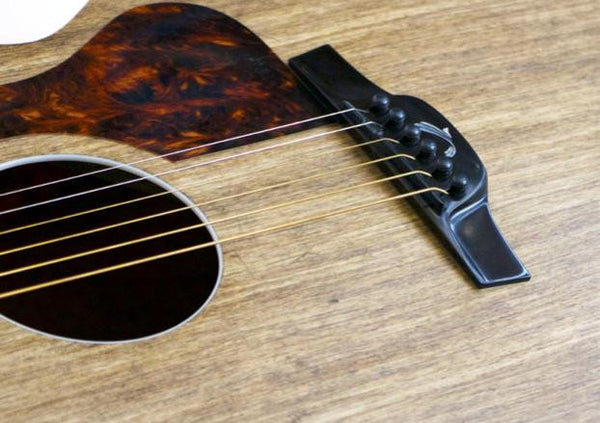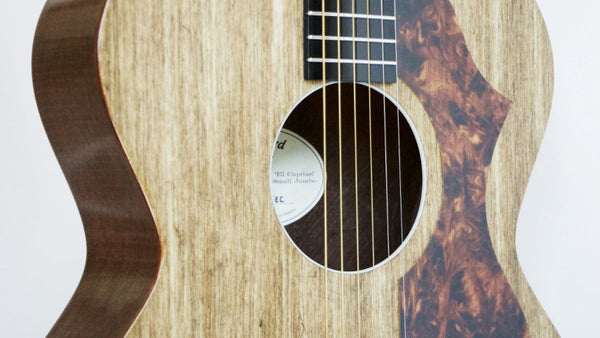From Acoustic guitar magazine August 5th, 2014 | by Greg Olwell
Guitarists interested in Blackbird’s carbon-fiber instruments often have a goal in mind, one that’s outside of what many would think of as normal—or even a good idea
Take Henry Kaiser. Like most of players, the guitarist known for his adventurous free-jazz excursions and world-music projects with fellow iconoclast David Lindley, likes to relax after a long day at work by playing an acoustic. But what Kaiser does with his Blackbird Rider travel guitar goes way beyond any manufacturer’s specifications.
“It seems normal to me to go outside with a guitar in minus-80 [degrees] in Antarctica,” Kaiser says. The guitarist, who’s also a professional research diver, brings his instrument on regular trips to the ice-covered desert continent whose zero-percent humidity would wreak havoc on a wood guitar, making it unplayable in a matter of days.
Kaiser doesn’t just take his Blackbird to his unconventional workplace, though. In a series of videos he posted on YouTube, he filmed a fellow diver playing the guitar as the team swam beneath 20 feet of ice in the Ross Sea.
Why would anybody do that?
“Because it’s a fun joke and it’s a useful image,” Kaiser says, in his signature rapid-fire delivery. “And because we can do it and nobody else can. Fewer people dive under the ice [in Antarctica] than have been in space.”
The only thing that went wrong with the guitar after being in the 28-degree salt water, Kaiser says, was that the tuners corroded and stopped working about two weeks later.
Travel Guitars on Steroids
Henry Kaiser’s antics represent the boundary-pushing extreme of usability and durability that Blackbird Guitars’ founder Joe Luttwak had in mind when he started the company in 2005. His mission remains the same: to change people’s ideas about where they can take their instruments.
It all started with Luttwak simply wanting to take a guitar on backpacking trips. “I wanted to have the ideal travel guitar,” he says. Luttwak holds up a Rider in the company’s San Francisco shop: “This is that selfish desire, out of control.”
Other makers have turned to carbon-fiber for its strength and imperviousness to climate change, but most carbon-fiber guitars have been more like high-tech versions of traditional wooden acoustics. Luttwak’s approach was to give the entire guitar a radical rethink, and he created the oddball-looking Rider steel-string (and its related models) to fulfill his passion to make the best-sounding, most reliable travel guitar possible. The oblong guitars quickly found an audience with players who preferred not to leave their guitars behind as they trekked the Himalayas or sailed the South Seas.
“For much the same reason I started this company, many of our customers wanted to expand the context of where they had an acoustic guitar with them,” Luttwak says. “That was traveling the world, going to extreme climates, but not wanting to give up a deep part of their personality.”
Luttwak’s small shop with about a half-dozen employees produces about 400 guitars and ukuleles per year, and has continued to introduce new models, some with a more traditional look—like the Lucky 13 and forthcoming El Capitan. Those models may be new guitars with a classic look, but the theme stays true to Luttwak’s vision for a good-sounding composite instrument: a unibody design that uses a single piece for the body and its hollow neck.
As Luttwak expands the company’s line, he’s also come across a new plant-based composite that he’s working into his latest models. It’s a new material that’s showing promise in a time when old growth woods for traditional guitar building are increasingly difficult to find, even on high-end guitars.
Appalachian Spring
Blackbird’s instruments might seem about as far away from a mountain dulcimer as a West Virginia holler is from a guitar shop surrounded by high-tech startups in San Francisco’s Mission District. But when Luttwak talks about what inspired him to build musical instruments, the connection becomes as plain as the weave on the company’s carbon-fiber guitars and ukuleles.
“I had played a dulcimer and was shocked at the frequency response and volume from of this small instrument,” Luttwak says, lifting up his Rider and pointing to the features inspired by the humble dulcimer: “Hollow neck, hollow head, and one-piece design—the notion was, if they can do it in a dulcimer, why can’t we do it in a guitar?”
Luttwak is sitting in the company’s upstairs lounge surrounded by comfortable modern furniture and several guitars hanging from the walls. At 38, he’s affable and energetic, with a quick, sarcastic humor. An avid backpacker, he grew up in suburban Maryland just outside of Washington, D.C., and frequently headed west for treks into the Appalachian Mountains.
After graduating from the University of Rochester, in New York, with a history degree, he landed a job in the communications department at Ferrari’s factory in Maranello and also helped design a museum exhibit. He liked the design project so much that he eventually headed to San Francisco State University for a Master’s program in product design. On the West Coast, he continued camping and playing guitar, but found himself frustrated by the guitars that were being marketed for travel and backpacking.
“There were a lot of problems with travel guitars—the foremost being that they didn’t sound good,” Luttwak says, and laughs. “In my mind’s eye, I saw myself playing a travel guitar and cringing at the thin sound of each note.” His fantasy was to be able to tap into the inspiration that can come from playing an instrument in an inspiring environment. “I wanted to realize that fantasy, and that required making a good travel guitar for backpacking, one that sounded good and wasn’t fragile.”
A school experiment changed Luttwak’s life. He was helping a friend in his Master’s program work on a guitar design as part of an extra credit project when a professor suggested there might be something to an all-hollow unibody instrument. Prototyping the guitar combined Luttwak’s interests in design with his desire for a travel guitar that he’d actually want to play and hear on his backpacking trips.
That’s when Luttwak remembered the mountain dulcimer—the small plucked stringed instrument with a hollow neck and body design. But constructing a working hollow guitar was easier said than done. Others had tried it—early on, Orville Gibson attempted one-piece bodies and necks, and Knutsen and Weissenborn had made hollow-neck guitars—but wood was just not durable enough for a travel guitar that feels and sounds like a guitar. Luttwak had to find something else.
“Composites were clearly the solution.”
Meet the Acoustic Ferrari F1
Luttwak needed an alternative material that would be tenacious enough for back country trekking and also sound better than any other travel guitar he’d ever played. He decided to apply some of the experience he got at Ferrari.
“It’s the intersection of two fields coming together, and that’s where a lot of interesting ideas happen,” Luttwak says. “The F1 unibody meets the acoustic guitar.”
The leap wasn’t exactly simple. “OK, hollow necks require composites, but what I didn’t understand was that it required a deep understanding of composites,” he says, with a self-effacing laugh. Then he gets serious again: “It was a steep learning curve at the beginning.”
Luttwak’s experimentation led him first to carbon fiber, but there were other things to consider—like how to actually construct a playable guitar. As he dove into studying composite structures and adhesives, he also began learning as much as he could about guitar-making. Fortunately for him, several forward-thinking luthiers—including Jeff Traugott in Santa Cruz, and Ervin Somogyi in Oakland—lived and worked nearby, and were helpful in guiding him through some of the “big ideas” of guitar building. They taught him alternative bracing techniques and encouraged him to think of the top of the guitar as an air pump, as well as instructing him on such mundane but important setup issues as how far the high E should be from the edge of the fingerboard.
With the goal of making a louder instrument, Luttwak’s studies led him to two design elements: an offset soundhole to allow more unbroken surface for the top to vibrate and a hollow neck to increase the interior volume. Another plus of using an offset soundhole is that it makes bracing the top for strength and tone easier than a standard round-hole guitar.
Luttwak’s search for composites has led him to new materials designed to reach mainstream guitarists who want more conventional-looking guitars and who may not need an instrument that can go underwater. He began to consider using other engineered materials. After much research and experimentation, he and his crew have pioneered the use of a bio-based composite the company calls Ekoa, a thin fabric made from flax fibers infused with resin. Ekoa is a stiff-but-flexible sheet with natural, unidirectional hairs that give the material a grainy, wood-like look and color. But it’s not just a look; it’s a bona fide plant grain that bends in your hands much like a piece of spruce.
Luttwak runs his fingers along the grain lines of a sheet of Ekoa that will later be used in the Clara ukuleles the company is working on. He explains part of the material’s appeal is that since flax is a plant, the long flax fibers in Ekoa are similarly structured to the grain lines in woods used for guitar tops.
Where this new material is different from wood is how it’s layered. Blackbird uses a structure that’s more like the double-top guitars gaining popularity in the nylon-string world. However, instead of using cedar and spruce, Luttwak and his team use two layers of Ekoa arranged perpendicular to each other and sandwiching a core made from Nomex, a honeycombed polymer that’s used as the center layer for double-top classical guitars. The resulting triple-layer structure produces strength along the length and width of the guitar, resulting in a balanced laminate that he says is flatter and stiffer than wood.
Luttwak’s research also showed him that Ekoa shares an important trait with the old-growth woods favored for guitar making, dampening some vibrations so that the resulting sound is much sweeter to our ears than a material that permits all frequencies, even harsh ones, from being reproduced. The material’s dampening property comes in part from its lower density and is one of the reasons why he’s pursued this material for building guitars. As anyone who’s ever played a guitar with maple back and sides can attest, high-density materials like maple excel at transmitting high-frequencies and they need some dampening to mellow out those frequencies that can get overly harsh and bright.
The crew has been honing its technique with the Clara uke, which Luttwak began as a project for his four-year-old daughter who wanted an instrument she could play, and Blackbird plans to release the first guitar made from flax composite, the El Capitan, this fall.
Oh, The Places You’ll Go
Luttwak constantly hears tales of exciting places people have taken his guitars. One guy hiked in the Himalayas with his Blackbird on a strap—no case. A New Orleans busker plays his on the hot streets of the Big Easy. Though Luttwak does not recommend taking a guitar with electronics for a swim, one customer forgot and took his guitar swimming during a camping trip; miraculously, the MiSi pickup and preamp survived.
Among guitar makers and players who elevate things like wood grain and hide glue to fetish items, it takes a considerable belief in one’s vision—and a whole lot of good old-fashioned stick-to-it-ness—to keep going in a direction of using composite materials joined by epoxy. But that’s what Luttwak has done. It’s his spirit of adventure and quest for better tone that informs every aspect of Blackbird’s guitars, from the carbon-fiber, hollow-neck design to the reduced-mass bridge and strap buttons fastened with molly bolts so they don’t pull out.
“We changed a lot of things; we changed a lot of rules,” Luttwak boasts. “And we changed the context of where people play guitar.”




